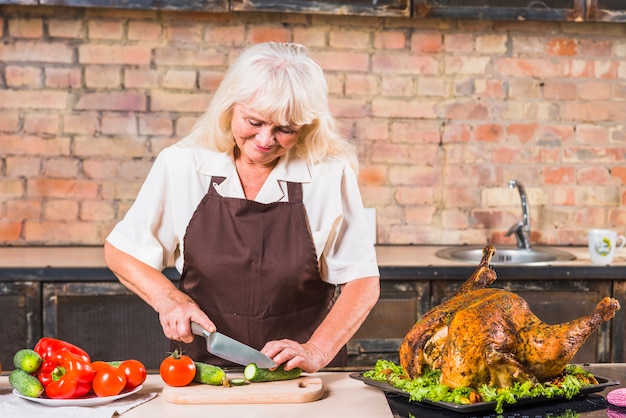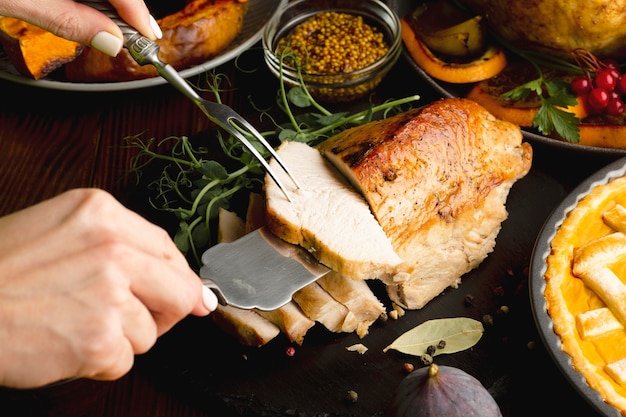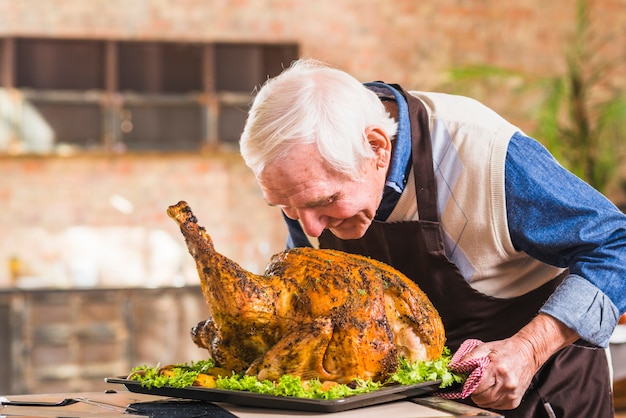Cooking a chicken can feel like a bit of a culinary gamble, right? You flip through recipe books, each with a different cooking time, and you just want to be sure you're not serving up a bird that's still a bit pink in the middle. I've been there - I've definitely had my share of dry, overcooked chicken disasters, and even the occasional slightly undercooked one, which is never ideal! But over the years, I've learned a few tricks and tips that have transformed my chicken-cooking game.
(Part 1) The Chicken's Tale: Choosing the Right Bird

A Chicken's Journey: Free-Range vs. Supermarket
First things first, let's talk about the chicken itself. The flavour and texture of your final dish all starts with selecting the right bird. I personally favour free-range chickens – they've had the luxury of roaming around outside, pecking at grass and enjoying the sunshine. This usually results in a richer flavour and a slightly firmer texture. However, let's be honest – sometimes a supermarket chicken is the more practical choice.
Chicken Types: Whole, Pieces, or Joints?
There are three main types of chickens you'll typically find in the supermarket:
- whole chicken: This is the classic choice for a roast dinner. A whole chicken gives you the most meat and is great for roasting, but if you're looking for a quicker option, there are alternatives.
- chicken pieces: You can also find individual chicken pieces, like breasts, drumsticks, thighs, and wings. These are perfect for stir-fries, curries, or simply grilling. They cook faster than whole chickens, so you can get a meal on the table quicker.
- Chicken Joints: These are whole chickens that have been cut into sections, offering a good balance between meatiness and ease of cooking. They're great for a quick and easy roast, and often come pre-seasoned for extra convenience.
Reading the Label: Decoding Packaging Instructions
No matter what type of chicken you choose, always check the packaging for instructions on how long to cook it. Some manufacturers will specify the cooking time based on the weight and size of the bird. This is a good starting point, but we'll delve into that a bit more later.
(Part 2) The meat thermometer: Your Kitchen's Secret Weapon

Why a Meat Thermometer is Essential
You could spend hours scouring recipe books and online articles, but there's one tool that will truly revolutionise your chicken cooking: a meat thermometer. It's like having a little magic wand that tells you exactly when your chicken is cooked to perfection, no more guesswork!
The Magic Number: 165°F (74°C)
The magic number to look out for is 165°F (74°C). This is the internal temperature that ensures your chicken is cooked through and safe to eat. No more worrying about undercooked poultry, just juicy and delicious chicken.
Finding the Perfect Spot: Thermometer Placement
You might be wondering, where exactly do I stick this thermometer? Well, the best spot is the thickest part of the thigh, avoiding any bones. Stick it in deep enough to get a good reading and ensure the thermometer isn't touching any bones.
(Part 3) roasting a whole chicken: A Classic Recipe

A Culinary Classic: The roast chicken
Alright, so you've chosen a whole chicken, and you're ready to roast it. This is where my trusty recipe for a classic roast chicken comes in. It's a simple yet incredibly satisfying dish that always impresses.
Preparing the Chicken for Roasting
First, you need to give your chicken a good pat dry with kitchen paper. This helps the skin to crisp up nicely in the oven. Then, season it generously with salt and pepper, and add any herbs or spices that take your fancy. You can even stuff the cavity with lemon wedges, rosemary sprigs, or garlic cloves for extra flavour.
Choosing the Right Temperature and Time
Now, pop your chicken into a roasting tin. The key here is to roast your chicken at a low temperature (around 350°F/175°C). Don't be tempted to crank up the heat - it will just lead to dry meat. As for the timing, it's about 20 minutes per pound for a whole chicken.
Checking for Doneness: The Thermometer's Crucial Role
Now, this is where the magic thermometer comes in. Stick it into the thickest part of the thigh, and keep checking the temperature every 20 minutes or so. Once it hits 165°F (74°C), your chicken is ready to be taken out of the oven.
Resting the Chicken: Allowing the Juices to Redistribute
Don't rush to carve it up right away! Let it rest for about 10 minutes before slicing. This will allow the juices to redistribute, giving you a beautifully moist and succulent chicken.
(Part 4) cooking chicken Pieces: A Guide to Different Methods
chicken breast: The Versatile Choice
chicken breasts are probably the most versatile piece of chicken you can get. You can pan-fry them, bake them, or grill them. For pan-frying, simply season them with salt and pepper, heat some oil in a pan, and cook them for about 5-7 minutes per side.
chicken thighs: Richer in Flavor
Chicken thighs are known for their richer flavour and juicier texture. They are perfect for grilling or roasting. If you're grilling, simply season them, preheat your grill, and cook them for about 5-7 minutes per side.
chicken drumsticks: A Classic Choice
Chicken drumsticks are a classic choice, and they're perfect for roasting, grilling, or baking. If you're roasting, simply place them in a roasting tin, season them, and roast them at 350°F (175°C) for about 30 minutes, or until they reach an internal temperature of 165°F (74°C).
(Part 5) Understanding chicken cooking times: A Breakdown
Factors Affecting Chicken Cooking Times
Here's the thing about chicken cooking times: they can vary depending on several factors:
- Size and Weight: A larger chicken will take longer to cook than a smaller one. A chicken breast will cook much faster than a whole chicken, for example.
- Cooking Method: Different cooking methods require different cooking times. Roasting takes longer than pan-frying, for example.
- Oven Temperature: A lower oven temperature will take longer to cook a chicken than a higher temperature.
General Chicken Cooking Times
Here's a general guide to chicken cooking times:
| Chicken Part | Cooking Time | Internal Temperature |
|---|---|---|
| Whole Chicken (3-4 pounds) | 1 hour 30 minutes to 2 hours | 165°F (74°C) |
| Chicken Breast | 20-30 minutes | 165°F (74°C) |
| Chicken Thigh | 30-40 minutes | 165°F (74°C) |
| Chicken Drumstick | 30-40 minutes | 165°F (74°C) |
Always Check for Doneness: The Importance of Patience
Remember, these are just general guidelines. It's always best to use a meat thermometer to check for doneness, especially if you're unsure. Don't be tempted to rush the process – a little extra time in the oven is better than serving undercooked chicken.
(Part 6) chicken cooking mistakes to Avoid
1. Overcrowding the Pan: Letting Your Chicken Breathe
One of the biggest mistakes people make is overcrowding the pan. This can cause the chicken to steam instead of cook evenly, resulting in a less crispy skin and potentially uneven cooking. Always leave enough space between the pieces of chicken so that they can brown properly and cook evenly.
2. Not Preheating the Oven: The Key to Even Cooking
Preheating your oven to the correct temperature is crucial for ensuring your chicken cooks evenly. If you don't preheat the oven, the chicken will take longer to cook and might not reach the right internal temperature, leading to uneven cooking and potential undercooked areas.
3. Not Basting the Chicken: Keeping It Moist and Flavorful
Basting your chicken while it's roasting helps to keep it moist and adds flavour. Use the pan juices to baste the chicken every 20 minutes or so, or even try a mixture of butter and herbs. This keeps the chicken moist and prevents the skin from drying out.
4. Cutting Into the Chicken Before It's Cooked: Safety First
The biggest mistake of all is cutting into the chicken before it's fully cooked. This can lead to undercooked chicken and potential food poisoning. Always use a meat thermometer to ensure your chicken reaches the correct internal temperature.
(Part 7) Leftover Chicken: Making the Most of It
Storing Leftover Chicken: Keeping It Safe and Fresh
So, you've cooked a delicious chicken, but you have some leftover. Don't worry, it's not the end of the world! Store your leftover chicken in an airtight container in the refrigerator for up to 3-4 days.
reheating leftover chicken: Options for Enjoying It Again
You can reheat your leftover chicken in a variety of ways:
- Microwave: This is the quickest way to reheat chicken, but be careful not to overcook it as it can dry out quickly.
- Oven: This is a good option for reheating larger pieces of chicken. Just place the chicken in a baking dish, cover it with foil, and bake it at 350°F (175°C) for about 15-20 minutes. This helps to retain moisture and keeps the chicken warm throughout.
- Skillet: If you want to add some extra flavour, you can reheat your chicken in a skillet with some oil or butter. Cook it over medium heat for about 5-7 minutes, or until it's heated through. You can also add vegetables and spices for a more substantial dish.
Creating Delicious Chicken Dishes from Leftovers: Creative Ideas
Leftover chicken is a blank canvas for delicious meals. You can shred it for chicken salad, dice it for stir-fries, or use it to make chicken soup. The possibilities are endless!
(Part 8) FAQs: Your Chicken Cooking Questions Answered
1. How do I know if my chicken is cooked?
The best way to tell if your chicken is cooked is to use a meat thermometer. The chicken is safe to eat when it reaches an internal temperature of 165°F (74°C) in the thickest part of the thigh.
2. Can I cook a frozen chicken?
You can cook a frozen chicken, but it will take longer than cooking a fresh chicken. You'll need to add extra time to the cooking time to allow the chicken to thaw completely. It's best to thaw it in the refrigerator overnight, but you can also thaw it in a cold water bath if you're in a hurry.
3. How do I prevent chicken from drying out?
To prevent chicken from drying out, it's important to roast it at a low temperature, and to baste it regularly with the pan juices. You can also try adding a little bit of butter or broth to the roasting pan. This helps to keep the chicken moist and prevent the skin from becoming dry and crispy.
4. What if my chicken is slightly pink in the middle?
If your chicken is slightly pink in the middle, it's important to cook it a little bit longer. You can check the internal temperature with a meat thermometer to ensure it reaches the safe temperature of 165°F (74°C). Don't be afraid to cook it a bit longer to ensure it's fully cooked.
5. Can I use leftover cooked chicken in other dishes?
Yes, you can definitely use leftover cooked chicken in other dishes. It's a great way to add protein and flavour to salads, soups, stir-fries, and many other dishes.
(Part 9) Conclusion: The Journey to Perfect Poultry
Well, there you have it, a comprehensive guide to cooking chicken. Remember, it's all about understanding the basics, choosing the right chicken, and using the right tools. With a little practice, you'll be whipping up delicious chicken dishes in no time. And don't forget, a good meat thermometer is your best friend in the kitchen. So grab your favourite chicken recipe, fire up the oven, and get ready to enjoy the perfect piece of poultry. Happy cooking!
Everyone is watching

How to Cook Frozen Lobster Tails Perfectly: A Step-by-Step Guide
RecipesLobster. Just the word conjures up images of lavish meals, special occasions, and a taste of luxury. But let's...

Pigs in a Blanket Cooking Time: How Long to Bake for Perfect Results
RecipesAh, pigs in a blanket. Just the name conjures up images of those delightful little parcels of crispy pastry en...

Pork Fillet Cooking Time: How Long to Cook It Perfectly
RecipesPork fillet, or tenderloin as it's sometimes called, is a real favourite in our house. It's so versatile, and...

The Ultimate Guide to Cooking Delicious Frankfurters
RecipesLet's face it, we all love a good frankfurter. It's a classic, simple, and always satisfying. But let's be rea...

Wolf Meat Recipes: A Guide to Cooking Wild Game
RecipesLet's be honest, you don't see wolf meat at your local butcher shop every day. It's a bit of a wild card, but ...
